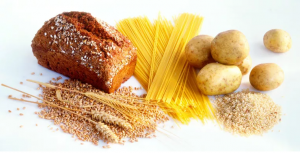Are you a dancer and are you feeling less energetic in the studio lately? During competition season it may be harder for you to stay healthy or feeling at your optimal best. It may seem that you are suffering injury after injury.
Your diet could be the culprit. If you are not fueling your body with the proper foods, your dancing, as well as your health may begin to suffer. Every dancer should follow a healthy diet. The body performs at its best when filled with the proper foods. Dancing requires lots of energy, so dancers must consume enough calories to keep up with physical demands.
A dancer's diet should consist of a good balance of carbohydrates, proteins, fats, vitamins and minerals and adequate fluids. That means a balanced diet composed of a wide variety of fresh fruits and vegetables, whole grains, dairy products, and proteins. Take a look at what composes a recommended dancer's diet in greater detail.
Carbohydrates
Carbohydrates (starches) should comprise about 55-60 percent of a dancer's diet. The better choices of carbs include whole grain cereals, bread, and pasta, sweet potatoes, baby potatoes, root vegetables like carrots, parsnips and turnips, beans, quinoa, and fruit. It is best to steer clear of refined, highly processed foods that do not have many nutrients, such as cakes, cookies, biscuits, sweets and soft drinks.
Proteins
Proteins are important for building and repairing muscles and bone health. Amino acids in proteins are responsible for the growth of every component and maintenance of every basic function in the body. Proteins should comprise about 12 to 15 percent of a dancer's diet. Good sources of protein include lean meats like poultry and fish, beans, legumes, yogurt, milk, cheese, nuts, soy milk, and tofu. Plant-based milk, other than soy, such as hemp, rice, almond and coconut milk are not very high in protein.
Fats
Many dancers worry about gaining weight, and therefore, strictly limit their fat intake. However, a diet too low in fat can impair performance and may cause serious health consequences for the dancer. A mix of fat and glucose is needed for energy during exercise and at rest. Fat is an important fuel for muscles and aerobic exercise. A dancer's diet should be composed of about 20 to 30 percent fat. Aim to eat foods that are composed of healthy fats, usually meaning it is low in saturated fats. Healthy fat foods include olive oil, cheese, milk, avocados, nuts, and seafood.
Vitamins and Minerals
Vitamins and minerals play important roles in the body, such as energy production and cell formation. Different fruits and vegetables contain plant chemicals that can optimize performance and serve as antioxidants. An easy way to think of this is that different colors in fruit and vegetables represent different effects, so a dancer is well advised to embrace the concept of "eating across the rainbow." In general, the orange, red and dark green fruits and vegetables supply the highest content of vitamins A, C, and E.
Many dancers are vitamin D deficient. This deficiency reduces the ability to regenerate muscle or bone following injury or can contribute to stress fractures. Foods rich in vitamin D include fatty fish, milk, cheese, and eggs. Vitamin D supplementation has also been associated with increased vertical jump height and isometric strength, as well as lower injury rates among elite ballet dancers. A multivitamin is suggested for those who do not consume an adequate variety of nutritious foods.
Fluids
Water is required to regulate body temperature, maintain circulation, maintain salt and electrolyte balance and remove wastes. Fluids are lost through sweat created by the body's unique cooling system. Because it is possible to lose large amounts of water before becoming thirsty, dancers should remember to drink small amounts of fluids before, during and after workouts.


Responses